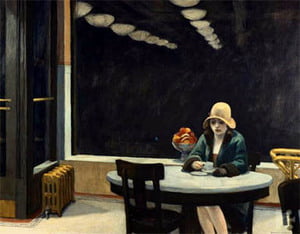The 1920’s in the United States were a turbulent time. Prohibition was in full swing, and the denunciation of innocence sparked by the widespread popular noncompliance with the mandates of the 18th amendment and the Volstead Act has changed the shape of America forever. Popular culture, hedonism, and the joys of the city were concepts that were most prominent in this era. The Automat, by Edward Hopper intends to embody a sense of this time period into its canvas. However, it is not meant to praise but to expose and unveil.
The woman sits dead silent and alone in an automated diner. The window behind her reveals a deep, opaque darkness, punctuated only by a string of saucer-like lights, each monotonous and similar, each reflected in its neighbor in shape and distinction, and extending into the automat only to be reflected in diminishing forms upon the smoky glass. The only source of light comes from within the diner; it reveals the entire scene, and coats it with garish, whitewashed colors. One can almost feel the despair in the air, and yet, there is no escape. As with Hopper’s Nighthawks, there is no exit, no way out into the circle of being. The woman is abandoned and trapped within…
The first theme and most clearly seen theme in this painting is loneliness and detachment. A viewer looking at the painting for the first time can easily grasp a sense of the absolute quiet and distance the atmosphere dictates. The woman sits alone in an automat, a blank void painted upon her face. She is the only main object in the picture. Outside the diner, we can see nothing. A veil of impenetrable darkness clothes the window into the outside and the only source of the “life-giving” light is within; the woman is “entrapped” within the automat, and cannot escape. She is completely detached and isolated; alone. No door is present in the scene, again emphasizing the effect of remoteness and seclusion. We can also look at the colors present in the painting. The woman’s skin is painted with too-bright, whitewashed shades and appears translucent, wraith-like and ghostly. She is not a part of this world. This was the 1920’s. Although on its surface the Roaring Twenties was an era of jubilant culture, beauty is only skin deep. The Twenties emphasized extroversion, and along with Prohibition boosting random acts of lawlessness and “fling-to-the-wind” careless hedonism, was an era where people care nothing for what really matters, but instead devoted their lives to pleasure. The city can embody a large part of this. The city is an entity of isolationism. There is a separate sphere for everyone in an urban environment, and meaningful interaction is thus decreased. On the streets, the law of ignorance is presented and preserved. We purposefully ignore and are ignored; passing like ghosts between the rambling hordes. Urban personal isolation, detachment and impersonality are at the heart of Automat.
Building upon this, our second theme is dehumanization. The woman is a fixture. She displays no movement or can we see any hint that there is an impetus to movement. Her face is emotionless and still. Her eyes are dark and staring and her mouth lightly closed, her face directed down into her hands. She is fixed and static, like a corpse or statue and we can only judge her as such. The colors invested in her figure, dark blacks and garish whites, also seeks to bring out the sense of strangeness and wrongness with her humanity. Also, the viewer at first glance sees the women, but if one looks more closely, the central object of the painting is in fact the bowl of fruit. The lively color of the bananas and oranges gives it life and a sense of liveliness, whereas the woman lies cold and dead to its side. Another symbol of human detachment is the automat. An automat is an automated diner, where coin-operated machines serve food. The presence of the woman in an automat, detached from the outside human society with the darkness of the windows, once again underscores the removal of the woman from humanity. The light fixtures within the diner symbolize the guiding and embracing light, and it is only in the automat that we see such lights. Despite their impersonality and inhumanity, it is all the lonely woman has. The automated diner embraces her, and she cannot bear to let go. Her human spark has been extinguished in the crushing shadows of the pressures of the city. The Roaring Twenties was not a time for personal values or beliefs. The Waste Land by T.S.Eliot describes the loss of values in modern human society. The tabloids, celebrities, alcohol; there was no concern in the general public except for the superficial, pointless issues that make up the popular culture of that time period. The pursuit of self-pleasure and personal profit has destroyed American’s inner humanity, the core of creativity and interaction. By using new amenities that encourage disassociation, such as the automat, human interaction is discouraged. Every human being eventually gets to the point where there is no purpose in humanity, where they question the goals of their existence, and find it lacking. The city exacerbates things by forcing adherence to its culture, assimilating the unwilling into a style of existence characterized by activity, its speed and veracity. There is no time for interaction; there is no time for humanity. All is overwhelmed and consumed and incinerated in the roaring fires of the era and metropolis of the 20’s.
Now, we come to the impacts of the city that we can observe upon the woman’s face. A look of welled up depression instantly sublimates from her eyes; downcast and slanted , they look to the lower right while her mouth is turned up slightly in a pained grimace of being. Her face is slack and apathetic. There is no energy in her life, for her existence is worst than death, for her humanity is devoured and there is nothing left on Earth for her anymore. This reflects the dehumanization and urban depression that we see in cities and metropolitan areas all the time. Is there true, distinct purpose in life if one simply repeats the actions of one’s compatriot, of one’s sweltering millions of compatriots? Can humanity survive alone and outcast, pariahed from humanity and yet embraced and swallowed by the roaring millions of urbanity. One is isolated from warmth but given skimming glance; is that enough? The melancholy of being will always spread once one has realized that existence serves no great change in the world, that each day brings nothing new and nothing to move and act for. Such is apathy and such is depression. This was the city. The time period of the 20’s and before brought about the changes to a city in many ways. The Great Migration brought African-Americans from the south into the metropolises of the north. The Jazz Age struck, and all America was engaged in a celebration of indulgence. Prohibition did nothing to stem this tide. If anything, it fueled it. Crime and terror and violence and war and alcohol and movies and films and riches and dancing and jazz and music and the ROARING TWENTIES crashed about America. In this, the exterior of being was emphasized, while the inner tranquility of being was flung to the wayside. In this, dehumanization is a crucial effect. Depression continues to affect millions today.
The Automat, along with many of Hopper other paintings, reflect the isolation of the urban population, each living and existing not ten feet from each other and yet separated by a distance beyond mere movement. Such is a gulf of the attitude of being. The city was the ground for dehumanization as every iota of humanity is systematically replaced, destroyed, or ignored. Hopper’s painting was a subtle way of showing the effects of urban life, the alienation and estrangement afforded the city dweller.




